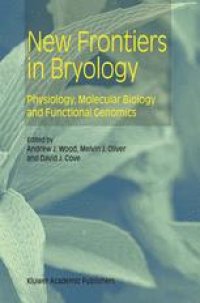
Ebook: New Frontiers in Bryology: Physiology, Molecular Biology and Functional Genomics
- Tags: Popular Science in Nature and Environment, Plant Sciences, Ecology, Plant Physiology
- Year: 2004
- Publisher: Springer Netherlands
- Edition: 1
- Language: English
- pdf
The mosses (Bryophatea, Musci) are a diverse and widely distributed group of land plants. Mosses are attractive experimental plants because they exhibit the traditional attributes of good model systems (Le. ease of growth & maintenance, fast generation time, and amenable genetics) with the added advantage of a haploid gametophyte that allowed developmental mutants to be recovered with relative ease. In addition, mosses with the ability to tolerate extreme environmental conditions offer realistic models for the analysis of environmental stress-tolerance; particularly when compared to tracheophytes such as Arabidopsis thaliana in which these important plant phenotypes are either not clearly expressed or entirely lacking. And, in one of the most exciting developments in Plant Biology, efficient homologous recombination occurs in the moss Physcomitrella patens. The ability to perform efficient homologous recombination (Le. gene knock-outs) in P. patens is at present unique amongst all plants and represents an extremely powerful technique for the functional analysis of many plant genes. Over the past 5 years, a world-wide community of moss researchers has evolved. A highly successful "Moss" conference has been held annually (l998-Mumbai, India; 1999-Carbondale, IL, USA; 2000-Villars, Switzerland; 200l-0kazaki, Japan; 2002-Ambleside, UK; 2003-St. Louis, MO, USA) with "Moss 2004" planned to be held in Frieburg Germany. These conferences have been instrumental in the creation & development of strong collaborative ties, and the free exchange of both ideas and materials.
The mosses (Bryophatea, Musci) are a diverse and widely distributed group of land plants. Mosses are attractive experimental plants because they exhibit the traditional attributes of good model systems (i.e. ease of growth and maintenance, fast generation time, and amenable genetics) with the added advantage of a haploid gametophyte that allowed developmental mutants to be recovered with relative ease. And, in one of the most exciting developments in Plant Biology, efficient homologous recombination occurs in the moss Physcomitrella patens. The ability to perform efficient homologous recombination (i.e. gene knock-outs) in P. patens is at present unique amongst all plants and represents an extremely powerful technique for the functional analysis of many plant genes. From evolution and development to the homologous recombination and the creation of novel molecular tools, mosses are being used to elucidate fundamental biological processes in plants. This book provides a synopsis of the outstanding basic research being conducted using mosses as a model multi-cellular eukaryote.
The mosses (Bryophatea, Musci) are a diverse and widely distributed group of land plants. Mosses are attractive experimental plants because they exhibit the traditional attributes of good model systems (i.e. ease of growth and maintenance, fast generation time, and amenable genetics) with the added advantage of a haploid gametophyte that allowed developmental mutants to be recovered with relative ease. And, in one of the most exciting developments in Plant Biology, efficient homologous recombination occurs in the moss Physcomitrella patens. The ability to perform efficient homologous recombination (i.e. gene knock-outs) in P. patens is at present unique amongst all plants and represents an extremely powerful technique for the functional analysis of many plant genes. From evolution and development to the homologous recombination and the creation of novel molecular tools, mosses are being used to elucidate fundamental biological processes in plants. This book provides a synopsis of the outstanding basic research being conducted using mosses as a model multi-cellular eukaryote.
Content:
Front Matter....Pages i-xi
Molecular Phylogeny of Bryophytes and Peculiarities of Their Chloroplast and Mitochondrial DNAs....Pages 1-16
Genomes and Databases....Pages 17-35
Principles of Targeted Mutagenesis in the Moss Physcomitrella Patens ....Pages 37-49
Applied Genomics in Physcomitrella ....Pages 51-70
Molecular Biology and Genomics of the Desiccation Tolerant Moss Tortula Ruralis ....Pages 71-89
Evolution of the Organellar Transcription Machinery in Bryophytes and Vascular Plants....Pages 91-110
Gene Tagging, Gene- and Enhancer-Trapping, and Full-Length cDNA Overexpression in Physcomitrella Patens ....Pages 111-132
Lipid Metabolism in Mosses....Pages 133-155
Phytochrome in Mosses....Pages 157-176
Blue/UV-A Light Signaling in Moss....Pages 177-188
The Use of Mosses for the Study of Cell Polarity....Pages 189-203
The mosses (Bryophatea, Musci) are a diverse and widely distributed group of land plants. Mosses are attractive experimental plants because they exhibit the traditional attributes of good model systems (i.e. ease of growth and maintenance, fast generation time, and amenable genetics) with the added advantage of a haploid gametophyte that allowed developmental mutants to be recovered with relative ease. And, in one of the most exciting developments in Plant Biology, efficient homologous recombination occurs in the moss Physcomitrella patens. The ability to perform efficient homologous recombination (i.e. gene knock-outs) in P. patens is at present unique amongst all plants and represents an extremely powerful technique for the functional analysis of many plant genes. From evolution and development to the homologous recombination and the creation of novel molecular tools, mosses are being used to elucidate fundamental biological processes in plants. This book provides a synopsis of the outstanding basic research being conducted using mosses as a model multi-cellular eukaryote.
Content:
Front Matter....Pages i-xi
Molecular Phylogeny of Bryophytes and Peculiarities of Their Chloroplast and Mitochondrial DNAs....Pages 1-16
Genomes and Databases....Pages 17-35
Principles of Targeted Mutagenesis in the Moss Physcomitrella Patens ....Pages 37-49
Applied Genomics in Physcomitrella ....Pages 51-70
Molecular Biology and Genomics of the Desiccation Tolerant Moss Tortula Ruralis ....Pages 71-89
Evolution of the Organellar Transcription Machinery in Bryophytes and Vascular Plants....Pages 91-110
Gene Tagging, Gene- and Enhancer-Trapping, and Full-Length cDNA Overexpression in Physcomitrella Patens ....Pages 111-132
Lipid Metabolism in Mosses....Pages 133-155
Phytochrome in Mosses....Pages 157-176
Blue/UV-A Light Signaling in Moss....Pages 177-188
The Use of Mosses for the Study of Cell Polarity....Pages 189-203
....